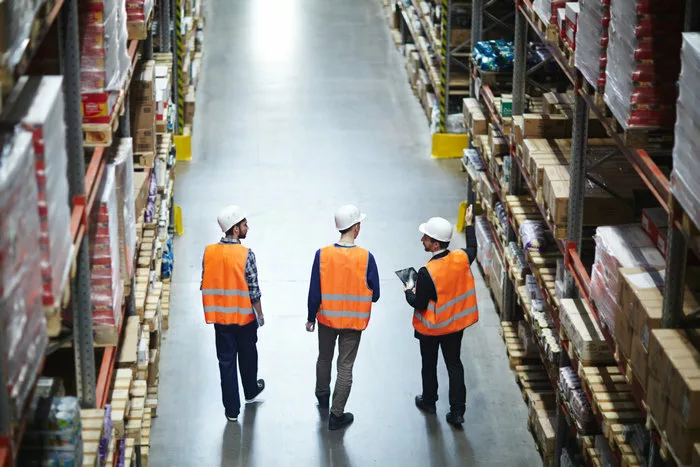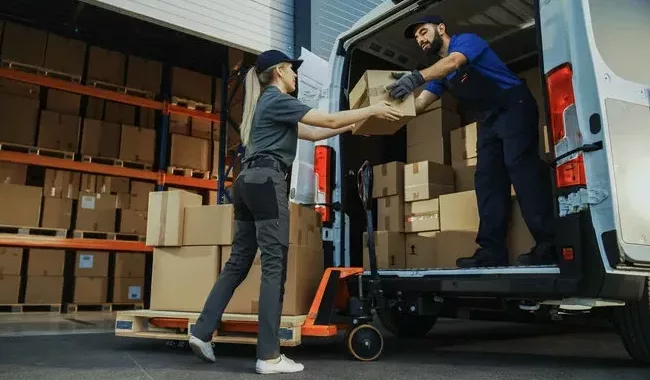Navigating China’s vast supply chain can feel overwhelming, and that is why getting your warehousing strategy right puts you one step ahead of other competitors. Whether it is importing goods for domestic distribution or managing exports, you need a logistics partner who understands local complexities.
In this article, we at Luckystar Logistics will explore the different types of warehouses available from bonded facilities to fulfillment centers and what you should look for in a reliable partner. Understanding these fundamentals will help you build a more efficient and cost-effective supply chain.

Table of Contents
Basics of Warehousing Service
Warehousing service in China provides secure storage for goods within the country’s borders. It’s a fundamental component of your supply chain, which is mainly comprised of two parts: physical warehouses and freight forwarder companies that act as warehousing partners.
Core Functions of a Warehouse
Chinese warehouses perform several essential operations that support your business.
- Receiving shipments from your suppliers or manufacturing partners.
- Storing products in a secure, organized manner, often within specific zones.
- Managing inventory with systems that provide real-time stock level visibility.
- Picking items from shelves based on customer or distribution orders.
- Packing goods securely for their next destination, whether domestic or international.
- Shipping orders directly to customers or to other distribution hubs.
The Role of a Warehousing Partner
A warehousing partner acts as your local expert, navigating China’s complex logistics landscape. They handle operational details if you lack a physical presence in the country. A reliable partner provides the technology and processes necessary for supply chain visibility and control.
Key Benefits of China Warehousing Service
China, as a major transportation hub and economic giant, boasts significant advantages with its warehousing service. These benefits directly enhance your supply chain’s efficiency and competitiveness.

Cost-Effectiveness and Scalability
By using the warehousing and fulfillment service from an external provider, you convert fixed infrastructure costs into variable operational expenses. This flexibility supports your business growth without major capital investment. You pay only for the storage space and services you actually use. Chinese warehouses offer competitive pricing due to several factors:
- Multiple international transport hubs like Shenzhen, Shanghai, Chongqing, etc.
- Strong infrastructure supports lower operational overhead.
- Government incentives, like free trade zones and other regulatory supports.
- Lower labor costs, but the workforce is still highly skilled.
- Abundant & low-cost land for warehousing in coastal regions and around transportation nexuses.
Advanced Technology and Automation
You gain real-time visibility and control over your inventory. Chinese warehouses aiming for international clients like us deploy intelligent warehouse management systems for superior management:
- Barcode scanners and RFID tags track individual items accurately.
- IoT devices monitor storage conditions and asset locations continuously.
- AI-driven systems forecast demand and optimize warehouse allocation.
These technologies minimize operational errors and streamline your entire fulfillment process, which often includes integrated packing, quality control, and customs handling.
Strategic Geographic Advantage
A warehouse in China strengthens your global supply chain by improving logistics, building local relationships, and increasing flexibility.
- Better Logistics & Lower Costs: Strategic locations near major ports and airports cut down on shipping times and inland transport costs. This helps you meet demand for faster delivery and compete globally.
- Stronger Local Partnerships: Being on the ground allows for closer collaboration with suppliers and manufacturers. This leads to faster production, better quality control, and more customized products.
- Greater Resilience: A local presence makes your supply chain more adaptable, helping you manage disruptions like trade disputes or global events, reducing risk and ensuring stability.
In short, a warehouse in China provides a long-term competitive advantage through efficiency, connections, and flexibility.
Safety and Tight Security Measures
Equally important is the level of security offered by Chinese warehouses. China is a major country with well-maintained public order, which amounts to lower risks of your cargo being vandalized or stolen. Despite this, a China warehouse would still have a complete set of security systems like CCTV cameras, access control systems and security personnel to protect your valuable inventory. This ensures that your goods are safe while in storage and minimizes the risk of damage or theft.
Types of China Warehouse Service Available
Your warehousing strategy in China directly benefits from selecting the appropriate service type and warehouse type for your specific logistics needs.

Public Warehouses
Public warehouses in China are owned and operated by third-party logistics (3PL) providers. If you choose to store your products in a public warehouse, you’ll essentially be renting space, along with other businesses. Public warehouses are ideal for small and medium-sized enterprises (SMEs) or businesses with seasonal storage needs due to their flexibility and cost-effectiveness. Key benefits of public warehouses include:
- Scalability: Adjust your storage space based on your current inventory levels.
- Shared resources: Share the cost of storage, labor, and equipment with other businesses using the same facility.
Private Warehouses
Private warehouses are owned and managed by individual businesses for their exclusive use. This option is suitable for large companies with high storage volumes and specific requirements. While private warehouses offer more control and customization over warehousing activities, they also involve higher costs than public warehouses. Advantages of private warehouses include:
- Exclusive access: The entire facility is dedicated to your business operations without sharing space or resources with others.
- Customization: Tailor the warehouse layout, equipment, and management systems to meet your business needs.
Bonded Warehouses
Bonded warehouses are government-regulated facilities that temporarily store imported goods before customs duties or taxes are paid. These warehouses are essential for businesses engaged in international trade, as they defer tax payments on imported goods until they are cleared for sale in the local market. By using bonded warehouses, you can effectively manage your cash flow and reduce customs-related complexities. Critical features of a bonded warehouse are:
- Duty deferment: Pay customs duties and taxes only when the imported goods are released for sale.
- Reduced customs clearance time: The warehouse operator handles customs documentation and procedures on your behalf.
How to Choose the Right Provider
The choice of a warehousing service provider directly impacts your supply chain’s efficiency and cost. You must evaluate several critical factors to ensure a successful partnership.

Evaluating Location and Infrastructure
You should prioritize providers with facilities near major transport hubs. China’s extensive logistics infrastructure includes the world’s largest high-speed rail system and busiest seaports, like Shanghai and Shenzhen. A strategic location near these hubs, logistics parks, or free trade zones minimizes inland transport costs and accelerates delivery times. If budget allows, it would also be beneficial to engage with emerging logistics nodes in second-tier cities for building sustainable, resilient supply chain networks.
Assessing Technology and Integration Capabilities
Smart warehouses, such as e-commerce fulfillment centers, often play a critical role in meeting evolving consumer demands. These highly automated warehouses specialize in rapid order processing and direct-to-consumer shipping. Their advanced capabilities are powered by technologies like digital twin, which enables the virtual simulation of operations to improve layout planning and workflow efficiency. Furthermore, artificial intelligence optimizes inventory and processes by forecasting demand to improve resource allocation.
This digital transformation and automation are the foundation for key advantages: they accelerate order turnaround using automated pick-and-pack systems and reduce operational errors through advanced inventory management technology. Ultimately, this integrated environment streamlines your entire fulfillment process, reduces operational risks with great inventory management. Ultimately, it ensures the smooth operation of high-volume sales for cross-border ecommerce businesses and direct-to-consumer brands.
Understanding Service Level Agreements (SLAs)
Chinese logistics providers operate in line with international norms, so the Service Level Agreement (SLA) will be included in the distribution services. The SLA defines critical performance metrics, including inventory accuracy rates, order fulfillment speed, and acceptable damage levels. A clear SLA ensures alignment on service quality, pricing structures, and communication protocols. You should reach a comprehensive agreement with your logistics service provider to minimize operational risks and safeguard your business’s reliability.
The Future of Warehousing in China
The future outlook of the cross-border logistics industry is heavily influenced by multiple factors; some of them boost market confidence, while some others pose a challenge to logistics companies and their customers alike.

Market Expansion and Premium Logistics
The China warehouse service market is expanding with significant new supply. The total premium logistics warehouse space on the Chinese mainland reached approximately 129 million sq m in Q2 2025. Around 1.1 million sq m of new supply was added during that quarter, with another 24.6 million sq m expected by 2027. This growth is driven by e-commerce festivals, cross-border e-commerce, and supportive consumption policies. However, you also see a slight quarterly decline in rents and an elevated vacancy rate of about 17.8% in Q2 2025, reflecting supply-demand imbalances in certain regions.
Technological Integration and Smart Warehouses
Currently, logistics networks benefit from the critical role of smart warehouses in meeting evolving consumer demands. Digital twin technology enables the virtual simulation of warehouse operations, improving layout planning and workflow efficiency. Artificial intelligence optimizes inventory and processes by forecasting demand to improve resource allocation. This digital transformation and automation streamline the fulfillment process and reduce operational risks.
Strategic Government Initiatives and Investments
The Chinese government introduces policies that emphasize logistics optimization and infrastructure development. Initiatives like China’s 14th Five-Year Plan and the Belt and Road Initiative enhance global connectivity, reinforcing China’s hub role in global supply chains.
This strategic context supports the sector’s long-term growth, underpinned by an overall logistics service market expanding at 6-8% annually.
Why Choose Luckystar Logistics?

Why choose us, Luckystar Logistics, as your warehousing solutions? The answer is that we tick every box in the qualities of an excellent freight forwarder.
- Our company is located in Ningbo, which is adjacent to Zhoushan port, a sea freight hub ranking 7th in the top 10 International Shipping Centers, and Shanghai port, the world’s busiest container port.
- We provide comprehensive logistics solutions by air, sea and land through our extensive local and global connections in the transportation industry.
- We have experienced staff who served clients from small businesses, multinational corporations, and industries such as manufacturing, retail, and e-commerce.
- We provide end-to-end services from warehousing to customs clearance, covering the entire process in supply chain management.
Contact us today for your fast, effective supply chain management!
Frequently Asked Questions
What are the typical payment structures for these services? How will I be billed?
Payment models are usually flexible and usage-based. Common structures include cost per pallet or per square meter for storage, plus pick-and-pack fees per order, and shipping charges. It’s crucial to clarify all potential fees upfront in the Service Level Agreement (SLA) to avoid hidden costs for services like long-term storage, handling returns, or special packaging requests.
What happens if my goods are damaged while in the warehouse? Who is liable?
Liability for damaged goods should be explicitly defined in your contract. Reputable providers will have insurance and clear procedures for such events. The SLA will outline the acceptable damage level and the process for filing a claim. It’s essential to understand these terms and ensure the provider has adequate insurance coverage to protect your inventory.
Can the warehouse handle special requirements, like temperature-sensitive products or high-value items?
Yes, many warehouses offer specialized storage solutions. Beyond general storage, you can find facilities with climate-controlled zones for electronics, pharmaceuticals, or food items, as well as high-security cages or vaults for valuable goods. You must discuss your specific needs during the selection process to find a provider with the appropriate capabilities.
How does the process of getting my goods into the warehouse from my supplier work?
The provider will have a detailed process for receiving your goods. This typically involves you providing an Advanced Shipping Notice (ASN). Upon arrival, the warehouse team will unload, count, and inspect the shipment for visible damage against the packing list. They will then check the items into their system, updating your inventory count. Your role is to coordinate the shipment from your manufacturer to the warehouse’s receiving dock.
Beyond storage and fulfillment service, what other value-added services might a provider offer?
Many warehouses offer services that can streamline your operations further. These can include product labeling/relabeling, light assembly, kitting (bundling multiple products into a single SKU), quality control inspections, and managing returns (reverse logistics). Inquiring about these services can help you consolidate your supply chain tasks with a single, efficient partner.
